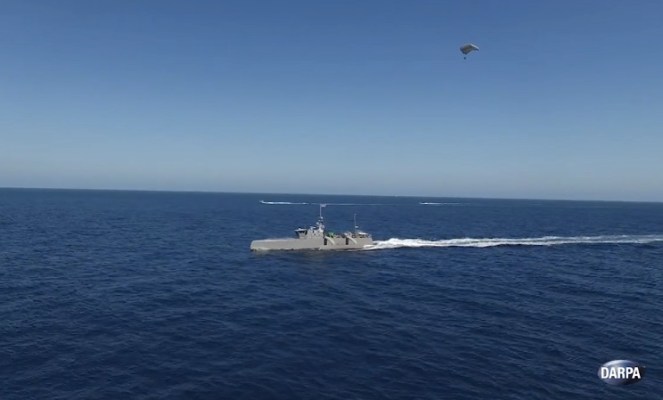DARPA’s submarine-hunting robot boat plies the seas off the coast of California. Smooth, grey, and purposeful, truly this vessel resembles other predators of the aquatic world in more than mien. But it turns out it’s also a sweet parasailing platform.
The Defense Department’s R&D wing just concluded a set of tests proving the concept of TALONS, or Towed Airborne Lift of Naval Systems. Basically the problem is that even on the largest ships, the highest point is likely no more than 150 or 200 feet above the water line. That’s all well and good if you’re spotting whales, but when artillery and missile strike distances are measured in miles, you want a bit more range.
TALONS takes the instruments that would normally be mounted atop the superstructure and gives them a tow line and parachute. It’s effectively parasailing. That puts the radar and other units up to 1,500 feet up, giving it five or six times the range.
The concept was shown off last year, but these tests were the last DARPA was to do before handing off the tech to the Navy — so why not do it in style? On a robo-boat?
“We just started at-sea testing of ACTUV in June, and until now we’ve been focused on getting the basic ship systems to work,” said the program’s manager, Scott Littlefield, in a DARPA news release. “TALONS was our first chance to demonstrate hosting a real payload and showing the versatility of ACTUV to do a wide variety of missions for which it wasn’t originally designed.”
A fleet of drone ships would not only be a nice deterrent against submarines, but a great testing platform as well. While at sea for a month or two, the ships basically take care of themselves, allowing a minimal crew to conduct experiments, perhaps even rent out space to research institutions.
Work on TALONS will be continued by the Navy, but ACTUV (Anti-Submarine Warfare (ASW) Continuous Trail Unmanned Vessel (yes, the acronym has an acronym in it)) will stay under the auspices of DARPA.
